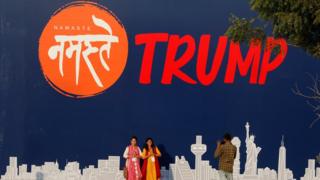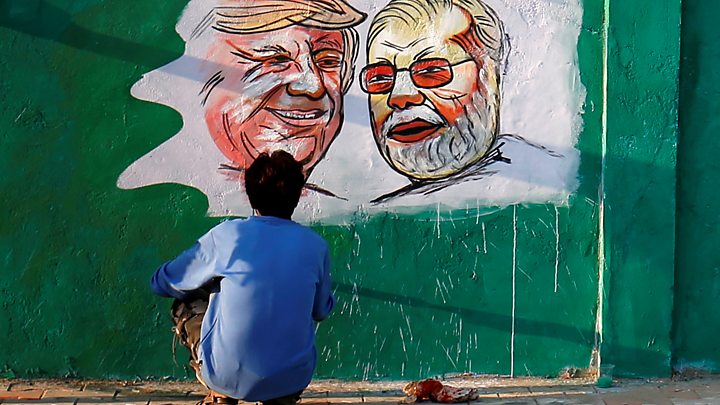What Donald Trump gets out of his trip to India
India is gearing up to impress the visiting US President Donald Trump on his first official trip to the world’s most populous democracy.
Tens of thousands are expected to line the streets to greet him in Ahmedabad city, in Prime Minister Narendra Modi’s home state Gujarat.
Mr Trump will inaugurate the world’s largest cricket stadium there in the presence of over 100,000 people, a spectacle expected to cost more than $13m (£10m).
The visit comes as India’s economy is under strain and unemployment is high.
Mr Modi is facing criticism at home and abroad over Kashmir and a controversial law that fast-tracks citizenship to non-Muslim religious minorities from three neighbouring countries.
“It will be a political boost and a good news story for him,” says Tanvi Madan, director of the India Project at the Brookings Institution think-tank in Washington. “He will be seen in visuals standing with the most powerful leader of the world, so to speak.”
But the Indian subcontinent has not figured much in Mr Trump’s “America First” agenda. So what’s in it for President Trump, who is known to hate long trips, and what does he hope to accomplish in India, when there is no dearth of domestic and international issues at home?
1. Effort to attract Indian-American voters?
The visit is being seen by many as a pleasant trip to a country where Mr Trump is not expected to face tough questions, but win some easy political points for his domestic politics.
Part of the aim is to give American voters a good image to point to when thinking of Mr Trump as he seeks re-election. “The visuals will be used by the Trump campaign to make the case the President is welcomed around the world,” says Ms Madan.
“That he has made America great and respected, especially when some polls have said the respect for the US has gone down on the international stage.”
Indian American voters might pay particular attention. About 4.5 million people of Indian origin live in the US today, but despite their relatively small numbers, Indian Americans are a growing political force in the country.
Those who can vote typically vote Democrat. In 2016, only 16% Indian Americans voted for Mr Trump, according to the National Asian American Survey.
“Indian Americans do not believe in cutting taxes and making government smaller. They favour social welfare spending,” says Karthick Ramakrishnan, a professor of public policy at the University of California, Riverside, who ran the survey.
Mr Trump has sought to court the Indian-American vote in the run-up to the 2020 election. In September, he appeared next to Mr Modi at a massive event in Houston, Texas named “Howdy Modi”, and declared: “You have never had a better friend as president than President Donald Trump”.
According to Mr Ramakrishnan, Mr Trump’s efforts in reaching out to India could help boost his numbers at the margins.
“I think there would be some short-term dividends but probably not to the extent that many Republicans might hope,” he says.
2. Trade Deal
A trade agreement with India following months of negotiations was expected to be the centrepiece of the visit – a big political win for Mr Trump if he could seal the deal.
The US-India bilateral trade stands at $160bn. But hopes of an agreement have been fading for weeks as the US expressed concerns over issues like rising tariffs, price controls and India’s positions in e-commerce. Immigration of skilled workers and the visa regime are other areas of concern.
India wants restoration of trade concessions under a tariff system called the Generalised System of Preferences (GSP), which provides additional benefits for products from least developed countries. Mr Trump terminated the GSP benefits for India in 2019.
“Even a limited deal would be an important signal to industry in both countries that US and India are serious about growing trade, and they can resolve issues,” says US India Business President Nisha Biswal.
However, she adds: “I am not optimistic because of what I have been hearing from both governments.”
3. The China Factor
President Trump has made being tough on China a central piece of his political brand, and many US concerns on China like the Belt and Road Initiative, access to South China Sea, and the untrustworthiness of its vendors are shared by India.
“I don’t think this visit would be happening without the strategic convergence between India and the US on China, particularly their concern about the Chinese actions and intentions in that region,” says Ms Madan.
A China-US crisis would adversely impact the Indian economy, but too much closeness between the two giants could leave India out of the equation.
The American side, in turn, questions whether the Indian quest for strategic autonomy would be a hindrance to a truly strategic partnership with the US.
Questions also swirl around whether India can rise as a counterweight to China in Asia or would it be sucked deeper into domestic and sub-regional politics. With hostilities rising between the US and China, Mr Trump may well find a friend in Mr Modi’s India, which has been seen as willing to criticise the Chinese.
4. Defence
Media reports suggest key multi-billion dollar defence deals are in the offing on Mr Trump’s India visit.
This may include the sale of helicopters for the navy. Before the trip, the US State department approved a possible sale of an integrated Air Defence Weapon System for $1.8bn.
As India tries to diversify its list of buyers, India recognises it has not made large defence purchases from the US recently, while it has done so from the Russians and French, said an analyst
“India and the US have become very close for strategic reasons. Even during the Trump years, you have seen defence and diplomatic dialogues,” said Ms Madan.
For Mr Trump, any chance to sell US hardware is a chance to tout to his supporters that he is boosting jobs and ‘Made in America’ manufacturing.
5. Building on the Trump-Modi chemistry
Mr Trump is seen by many as ‘transactional” leader who places a premium on personal relationships over geopolitics, and he believes that his ability to get on with foreign leaders earns him the ability to get things done.
This would be President Trump and Prime Minister Modi’s fifth meeting in eight months.
They call each other a ‘friend’. There are pictures of them hugging each other. “We are not treated very well by India but I happen to like Prime Minister Modi a lot,” Mr Trump told reporters days before his trip. For Mr Trump – and Mr Modi – exhibiting a level of bonhomie can help smooth over differences when tough talks come up.
In the end, it is not a trip made with a very clear set of objectives, says Joshua White of the Johns Hopkins School of Advanced International Studies.
For Mr White, it is more likely that the impulsive Mr Trump will take his trip, shake hands and pose for pictures, “and the bureaucracy figures out what can be gained on the policy front”.
Source: Read Full Article




